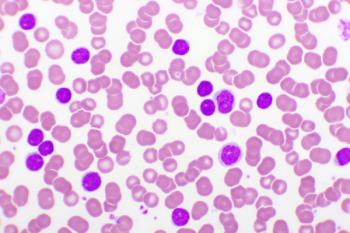
- July 2025
- Volume 31
- Issue Spec. No. 8
- Pages: SP517-SP519
Engagement Is Key to Supporting Patients Between Cancer Treatments
Key Takeaways
- Symptom monitoring programs require active patient participation and prompt provider response to be effective in reducing hospital visits.
- A digital app for HSCT caregivers improved quality of life and reduced stress, showing potential for broader application.
An ASCO session on quality services shows how patient and caregiver engagement is crucial to gain better outcomes and cost savings from symptom monitoring efforts.
Monitoring symptoms can help keep patients with cancer out of the hospital—but programs only work if patients and other providers are equally engaged in this process, according to presenters at a session on quality care and health services research held Friday during the
Four oral abstracts covered different
From use of an app, to electronic patient-reported outcomes (ePROs), to reach-outs from lay health workers, the interventions reported mixed levels of success. The lesson across the session, chaired by Stephen M. Schleicher, MD, MBA, medical oncologist with Tennessee Oncology, and Veena Shankaran, MD, MS, of Fred Hutchinson Cancer Research Center at the University of Washington, is that symptom monitoring programs don’t work if patients don’t use them—and if oncology providers don’t respond quickly.
Lalan Wilfong, MD, senior vice president for value-based care at Thyme Care, asked after the presentations if investigators had measured how long it took for oncology providers to reach patients who reported symptoms.
“It’s not the ePRO that actually makes the speed to response,” Wilfong said. “What we found is that the nurses need to respond to any concerning symptoms within 2 hours or less in order to change the trajectory of ED visits and utilization.”
An App Reduces Stress Among Caregivers
Jamie Jacobs, PhD, program director for the Center for Psychiatric Oncology & Behavioral Sciences at the Massachusetts General Brigham (MGB) Department of Psychiatry, shared findings on how well a digital application called BMT-CARE worked to support caregivers of those undergoing hematopoietic stem cell transplantation (HSCT).1 While having a caregiver on hand is essential for patients undergoing HSCT, the experience can be stressful for the caregivers, with up to 40% having anxiety or depression, Jacobs said.
“These symptoms are treatable with known evidence-based interventions like cognitive behavioral therapy, but few interventions have really been developed and tested in this space, and few actually span the transplant course,” she said. Prior work has shown that in-person meetings with a therapist can add to the caregivers’ stress, because showing up for an appointment is not so easy.
Instead, investigators at MGB developed an app that could deliver 5 self-guided lessons on topics such as evidence-based behavior change and stress management. Users interacted with the modules at their own pace. In a randomized trial, caregivers using the app were compared with those receiving usual care, which was a single visit with a social worker; 125 caregivers took a quality of life (QOL) assessment 60 days after HSCT.
Results showed that caregivers using the app engaged for a mean of 133.2 minutes and reported higher QOL scores than those seeing the social worker (76.2 vs 69.9; P = .006). App users reported lower caregiving burden, less depression, and fewer symptoms of posttraumatic stress disorder. Anxiety levels did not differ significantly.
Now, the goal is to develop a trial to see if the app is scalable, Jacobs said. Investigators hope to “include several cancer centers to expand the demographic and geographic diversity of our caregiver sample and establish the generalizability of these findings,” she said.
An ePRO Effort Fails to Engage Half the Patients
Efforts to develop an electronic symptom reporting system had less success at a different Boston site, according to Michael Hassett, MD, MPH, breast cancer specialist and health systems research at Dana-Farber Cancer Institute. Supported by a grant from the National Cancer Institute, investigators deployed an ePRO system embedded in the patients’ electronic health record across 6 health systems.2
However, it did not bring significant drops in ED visits or inpatient stays at 30 or 90 days after treatment. “Only 51% of patients eligible to use the system used it to report symptoms,” Hassett said, citing possible engagement and health system level implementation barriers.
He highlighted system-level data involving 21,112 adults who use the ePROs and 18,830 adults who did not over 5 years. Patients had chemotherapy or were discharged after surgery for gastrointestinal (GI), gynecological, or thoracic cancer. The intervention resulted in 30-day ED event rates of 5.4% for the control arm and 6.2% for the intervention group; inpatient events involved 8.5% vs 9.1% of patients, respectively. Surgery patients had higher likelihood of an ED visit, but not an inpatient stay. Results varied across the health systems.
Results varied across health systems. “Heterogeneity of effect by health system and treatment suggest that healthcare structures, processes, and baseline performance may influence the uptake and impact of ePRO-based symptom management systems,” investigators concluded.
Lay Health Workers Are Effective With Older Patients
Manali Patel, MD, of the Division of Oncology, Veterans Affairs Palo Alto Health Care System, said she got lots of institutional pushback about deploying lay health workers to check in via telephone on patients with cancer who were at least 75 years old. But the system, deployed among Medicare Advantage (MA) beneficiaries at 43 clinics in California and Arizona, got results: Over a 12-month period, those receiving the phone calls had 53% lower odds of ED visit (OR, 0.47; 95% CI, 0.37-0.62) and 68% lower odds of hospital use (OR, 0.32; 95% CI, 0.20-0.51) than the control group.3
Among deceased participants, which included 32.9% of the control group and 35.5% of the intervention group, the latter had 68% lower odds of acute care (OR, 0.32; 95% CI, 0.12-0.88), with an average total cost of care that was $12,000 less per patient. Those getting the phone calls were 75% less likely to die in an acute care facility (OR, 0.25; 95% CI, 0.08-0.77).
Patel emphasized that MA members themselves helped design the system, in which the frequency of calls shifted over time based on patient need. “They didn't want to fill out an ePRO,” she said, but many appreciated the “warm touch” call that also worked to alleviate loneliness among patients.
The challenge for this approach in a real-world setting is figuring out how to pay for it. “If you reduce acute care and costs that go along with acute care, you are essentially helping the payer, but you’re bearing the costs,” she said. So Patel’s group engaged a payer for help designing a system that would offer an incentive to practices to conduct the calls, which began in 2011—long before the Oncology Care Model.
“This proactive symptom assessment intervention may be a sustainable, scalable, efficient, and effective approach to improve care for older adults with cancer,” investigators concluded.
Home Care Model Yields Mixed Results
Ryan Nipp, MD, MPH, a GI oncologist at theUniversity of Oklahoma, Oklahoma City, presented results for a Supportive Oncology Care at Home intervention, which failed to show a significant impact on rates of hospital admissions or ED visits. However, authors reported the initiative trimmed urgent clinic visits, significantly reduced symptom burden, and helped patients improve the ability to perform activities of daily living, suggesting there are lessons to be gained.4
The intervention involved patients within 50 miles of the hospital who were being treated with chemotherapy and/or radiation for pancreatic, rectal, gastroesophageal, and head and neck cancer, as well as non-Hodgkin lymphoma. Patients in the intervention group received contact, such as remote symptom monitoring, tracking of vital signs and body weight, as well as home care assessment of symptoms and structured communication with their oncologist.
Investigators enrolled 50.8% of eligible patients; 3 of the original 199 could not complete the program. The primary end point was not met, with 37.1% of the intervention group and 35.7% of the usual care group (UC) requiring hospital admission or ED visits. But there was a sizable different in urgent care visits—7.2% for the intervention group vs 24.5% for the UC group. Of note there were no significant differences in treatment delays of more than 7 days (29.9% vs 33.0%; P =.62), which hinted at Wilfong’s point about responsiveness.
Nipp said more work is needed in this area. “It will be interesting to see [if] the differences that we saw in functional status are driven by the idea that we improve the patient's symptoms over time,” he said.
Discussant Robert M. Daly, MD, MBA, of Memorial Sloan-Kettering Cancer Center, observed, “There’s a need to better understand patients with cancer perspectives on care in the home, and why those patients who chose not to enroll did so.”
Daly’s chief takeaways, considering the goals of the Triple Aim as well as the CMS’ recent
- The studies highlight the need to reduce geographic disparities and deliver care locally.
- The studies show how new tools and data can support proactive health interventions.
- The studies demonstrate the need for “robust evaluation of clinical programs, including costs,” as seen in Patel’s study.
- Innovative collaborations can drive practice transformation.
References
- Jacobs JM, Freese M, Barata A, et al. Psychosocial digital application for caregivers of patients undergoing hematopoietic stem cell transplantation (HSCT): a randomized controlled trial. J Clin Oncol. 2025;43(suppl 17):Abstract 11000. doi:10.1200/JCO.2025.43.17_suppl.11000
- Hassett MJ, Uno H, Tramontano AC, et al. Outcomes of an electronic patient-reported outcomes (ePRO)–based symptom management program (eSyM): a cluster randomized trial. J Clin Oncol. 2025;43(suppl 17):Abstract 11001. doi:10.1200/JCO.2025.43.17_suppl.11001.
- Patel MI, Agajanian HH, Voskanyan M, Agajanian R, Milstein A. Improving care of older adults with cancer: a randomized trial. J Clin Oncol. 2025;43(suppl 17):Abstract 11002. doi:10.1200/JCO.2025.43.17_suppl.11002
- Nipp RD, Johsnon PC, Neckermann I, et al. Randomized trial of a supportive oncology care at home intervention for patients with cancer receiving curative treatment. J Clin Oncol. 2025;43(suppl 17):Abstract 11003. doi:10.1200/JCO.2025.43.17_suppl.11003
Articles in this issue
Newsletter
Stay ahead of policy, cost, and value—subscribe to AJMC for expert insights at the intersection of clinical care and health economics.









































